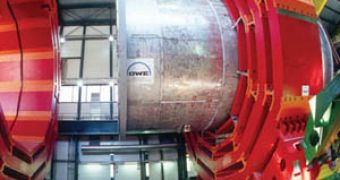Yet another step in the completion of the Large Hadron Collider was taken yesterday morning, as the final element of the Compact Muon Solenoid was lowered nearly 100 meters bellow ground. After more than eight years of work at the world's most powerful particle accelerator, scientists hope that they will be able to start initial experiments with the LHC until the end of this year. The CMS will be able to detect high-energy proton-proton collisions.
It was a rather stressful moment as the walls of the leeway only gave a few centimeters of room for error. Just one slight impact between the two and the final component of the CMS could have been plummeted towards the cavern, causing havoc inside. Fortunately, all went well and the build which started 14 months ago was successfully completed. The fifteenth element is an asymmetrical cap weighing about 1430 tonnes and consisting of ultra-fragile particle detectors capable of measuring the energy of particles produced by the LHC.
The LHC particle accelerator has been constructed in an unique way, mainly due to the fact that it spans over a very large area and requires to sit on a perfectly horizontal surface. But as the surface of the Earth is anything but horizontal, this meant that a tunnel had to be excavated to house it. Large elements of the device have been constructed above surface, tested, disassembled and transported to the designated location to be put into place. Austin Ball, the Technical Coordinator of the CMS project, believes that this might become a model to follow for future high-energy particle colliders, as it permits builders to save a lot of time by working simultaneously on different parts of the accelerator.
LHC's capabilities will allow physicists to test certain physical aspects related to the nature of matter, space and time, as well as their characteristics. As probably most of you already know, the only thing preventing physicists from creating the so-called Theory of Everything is gravity. The gravitational force is a direct consequence of mass, but there is no theory explaining how do elementary particles gain mass, or why do they have mass in the first place.
The Compact Muon Solenoid may answer part of these questions. The LHC could also show the true relation between the excess mass on the universe and dark matter, or why is there more normal matter than antimatter. It is said that String Theory does not provide any possible experiment to test it, nevertheless, the LHC could in fact detect the predicted extra spacial dimensions of the universe, if they exist. All that being said, the LHC will bring a valuable contribution to our understanding of the universe.

 14 DAY TRIAL //
14 DAY TRIAL //